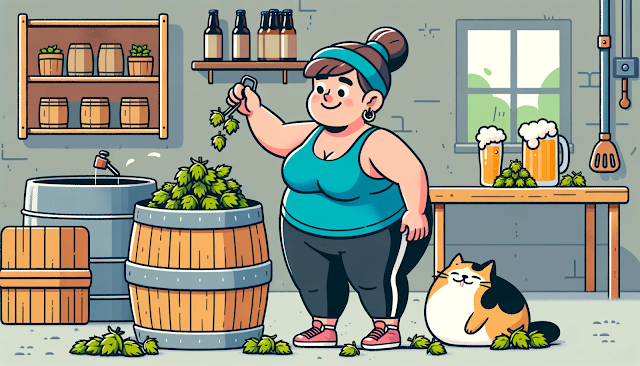Dry hopping is a technique employed by brewers to infuse beers, especially IPAs and pale ales, with a fragrant aroma and enhanced hop flavor. The method involves adding hops to the fermenter or keg post-fermentation. However, a common query among homebrewers and professionals alike revolves around the duration these dry hops should remain in the fermenter.
This article seeks to address these concerns, providing clarity on the optimal timing for dry hopping.
Can You Leave Dry Hops in Too Long?
Yes, leaving dry hops in the fermenter for an extended period can introduce unwanted flavors into the beer. Overextended contact time can lead to a vegetal or grassy taste, detracting from the desired hop aroma and flavor.
The aromatic oils from the hops are extracted within the initial days of dry hopping, and prolonged exposure does not necessarily translate to more aroma but can negatively impact the beer's overall profile.
How Long Do You Leave Dry Hops in Secondary?
When dry hopping in a secondary fermenter, the common practice, grounded in both empirical observation and the science of hop oil extraction, is to leave the hops in contact with the beer for a duration of 3 to 7 days.
This timeframe represents a sweet spot, allowing for the efficient dissolution of desirable aromatic compounds from the hop cones or pellets into the beer matrix without venturing into the territory of off-flavor development. Think of it like steeping tea – you want the flavorful compounds, but steeping for too long can lead to bitterness and astringency.
The magic of dry hopping lies in the extraction of volatile aromatic oils present in the lupulin glands of the hop. These oils, such as myrcene (contributing piney, resinous, and sometimes citrusy notes), linalool (floral, citrusy), and humulene (woody, earthy), are relatively non-polar and thus have a decent affinity for dissolving in the beer's ethanol-water solution.
The process is driven by diffusion – the movement of these compounds from an area of high concentration (the hop material) to an area of low concentration (the beer). Over 3 to 7 days, this diffusion reaches a point where a significant amount of these desirable aroma compounds has transferred into the beer, creating that sought-after hop bouquet.
As this article correctly points out, the physical presentation of the hops – whole leaf versus pellet – significantly influences the kinetics of this extraction. Hop pellets, being finely ground and compressed, boast a vastly increased surface area compared to their intact whole leaf counterparts.
This greater surface area provides more points of contact with the beer, leading to a faster and more efficient diffusion of the aromatic oils. Think of it like using ground coffee versus whole beans for brewing – the ground coffee releases its flavors much quicker. Consequently, brewers using pellet hops might find that optimal aroma extraction occurs towards the shorter end of the 3-to-7-day spectrum, while those using whole leaf hops might need to lean towards the longer end to achieve a similar level of hop intensity.
However, extending beyond this window risks extracting less desirable compounds.
How Long After Dry Hopping Can I Bottle?
Post dry hopping, patience is a virtue, and allowing the beer to settle for an additional 1 to 2 days before bottling is a scientifically sound practice for clarity's sake.
During the dry hopping process, especially with the use of hop pellets, a significant amount of fine hop particulate is introduced into the beer. These tiny fragments remain suspended, contributing to a cloudy or hazy appearance. Given enough time, gravity works its magic, causing these heavier particles to slowly sediment out of the beer and settle at the bottom of the fermenter. This natural clarification process results in a brighter, more visually appealing final product in the bottle.
Furthermore, as our BeerKitBrewer's guide touches upon, the way hops are stored prior to their use can subtly influence the compounds they contain and how readily they are extracted. Properly stored hops, kept cold and away from oxygen and light, will retain a higher concentration of those delicate aromatic oils we're after.
Suppose the hops have been compromised due to poor storage. In that case, the extraction kinetics might be slightly different, potentially influencing the brewer's perception of when the desired aroma has been achieved and, consequently, when they deem it ready for bottling. A short settling period after dry hopping provides a final opportunity for any remaining hop-derived compounds to integrate into the beer and for particulate matter to drop out, ensuring a cleaner and more refined final product.
How Long Do You Leave Dry Hops in a Keg?
When dry hopping directly in a keg, the hops can be left in for the duration of the beer's consumption, provided they are contained within a mesh bag or hop canister. This method, often termed "keg hopping", allows for a continuous infusion of hop aroma. However, the same rules apply; overexposure can lead to vegetal flavors. It's essential to taste the beer regularly and remove the hops once the desired aroma intensity is achieved.
In Conclusion
Dry hopping, when executed correctly, can elevate a beer's aromatic profile, making it a favorite technique among craft beer enthusiasts. The key lies in understanding the nuances of hop exposure and ensuring they don't remain in contact with the beer longer than necessary. By keeping a vigilant eye on the calendar and relying on regular taste tests, brewers can master the art of dry hopping, producing beers with a tantalizing aroma that beckons with every pour.




